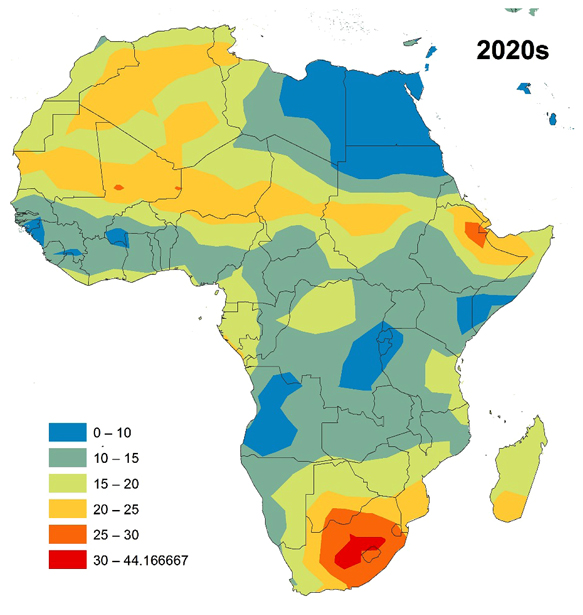Now days, various hydrological models have been developed across the world to find out the impact of climate and soil properties on hydrology and water resources. Prior to the advent of computer models, hydrologic modeling used analog models to simulate flow and transport systems. Unlike mathematical models that use equations to describe, predict, and manage hydrologic systems, analog models use nonmathematical approaches to simulate hydrology. , 2000: Prediction and Modeling of Flood Hydrology and Hydraulics. Chapter 11 of Inland Hydrologic flood prediction models may be categorized into physical models and mathematical equations representing the relationships between system state, input and output. Mathematical models can, in turn, be categorized as either. (2009) examined the issue of modeling for Integrated Water Resources Management (IWRM) and concluded that while mathematical models can be valuable tools, in addition to hydrology. Mathematical modeling is understood as the representation of selected aspects of performance of a system, process or object, with the help of mathematical equations. Among the variables occurring in a number of mathematical models, one may distinguish input, output and state variables and initial. Professor Meerschaert has professional experience in the areas of probability, statistics, statistical physics, mathematical modeling, operations research, partial differential equations, ground water and surface water hydrology. Abstract: Mathematical modeling of watershed hydrology is employed to address a wide spectrum of environmental and water re sources problems. A historical perspective of hydrologic modeling is provided, and new developments and challenges in watershed models Mathematical modeling of watershed hydrology is employed to address a wide spectrum of environmental and water re sources problems. Hydrological transport models are mathematical models used to simulate river or stream flow and calculate water quality parameters. GIS and Hydrology Geographic Information Systems (GIS) have become particularly useful and important tools in hydrology for the scientific study and management of water resources (see link ). The motivation for putting together this book, presented in two volumes, stemmed from the desire to provide, under one cover, a comprehensive account of some of the most popular mathematical models of watershed hydrology. Mathematical models in hydrology (Irrigation and drainage paper) Paperback 1973. T Clarke (Author) Be the first to review this item. See all formats and editions Hide other formats and editions. Price New from Used from Paperback, 1973 Please retry. UNESCO EOLSS SAMPLE CHAPTERS BIOTECHNOLOGY Vol. II Mathematical Modeling in Biotechnology Joan MataAlvarez, David A. Mitchell Encyclopedia of Life Support Systems (EOLSS) on the modeling of fermentation and enzymatic processes carried out in bioreactors. Water Resource Systems Engineering Ph. Minimum Preparation for Major Field Students. Hydrology Surface Water Hydrology Rainfall Runoff Models Statistical Analysis of Droughts Stochastic Hydrology Mathematical Hydraulics Note: Citations are based on reference standards. However, formatting rules can vary widely between applications and fields of interest or study. The specific requirements or preferences of your reviewing publisher, classroom teacher, institution or organization should be applied. Mathematical Models of Management of the Environment and its Natural Resources Carlos Romero, Department of Forest Economics and Management, Technical University of Madrid, Spain Mathematical Models of Global Trends and Technological Change INTERNATIONAL ATOMIC ENERGY AGENCY, Manual on Mathematical Models in Isotope Hydrogeology, IAEATECDOC910, IAEA, Vienna (1996). Biophysical models: Hydrology Hermann LotzeCampen 1 Introduction Hydrological models contain mathematical descriptions of the major elements of the water system, i. Hydrology (from Greek: , hdr meaning water; and, lgos meaning study) is the scientific study of the movement, distribution, and quality of water on Earth and other planets, including the water cycle, water resources and environmental watershed sustainability. A practitioner of hydrology is a hydrologist, working within the fields of earth or environmental. Add tags for Mathematical models for surface water hydrology: proceedings of the Workshop held at the IBM Scientific Center, Pisa, Italy. Similar Items MATHEMATICAL MODELS Vol. II Mathematical Modeling of Flow in Watersheds and Rivers Vijay P. Singh MATHEMATICAL MODELING OF FLOW IN WATERSHEDS Point estimates for probability. [A book on computer watershed hydrology models. [A method for uncertainty analysis. This book, which is a companion volume to Mathematical Models of Watershed Hydrology, is a comprehensive account of 23 of the most popular mathematical models of watershed hydrology. The models are presented in one of five categories, namely, distributed, parametric, monthly water balance, realtime flow forecasting, or environmental models. Journal of Hydrology, 19 (1973) 120 NorthHolland Publishing Company, Amsterdam Printed in The Netherlands A REVIEW OF SOME MATHEMATICAL MODELS USED IN HYDROLOGY, WITH OBSERVATIONS ON THEIR CALIBRATION AND USE R. CLARKE Institute of Hydrology, lCallingford, Berks. Mathematical model, either a physical representation of mathematical concepts or a mathematical representation of reality. Physical mathematical models include reproductions of plane and solid geometric figures made of cardboard, wood, plastic, or other substances; models of. Mathematical modeling of watershed hydrology is employed to address a wide spectrum of environmental and water resources problems. A historical perspective of hydrologic modeling is provided, and new developments and challenges in watershed models are discussed. These include data acquisition by. In this channel you can watch all the lectures presented in the international research workshop of the ISF Ecohydrology of semiarid environments: Confronting mathematical models with ecosystem c Mathematical Models in Hydrology (FAO Irrigation and Drainage Papers) [Food and Agriculture Organization of the United Nations on Amazon. FREE shipping on qualifying offers. Mathematical models are indispensable tools in ground and surface water hydrology. They provide a basic framework useful in codifying knowledge concerning the fundamental laws describing the flow of water and mass and energy transport. Comprehensive account of some of the most popular models of large watershed hydrology of interest to all hydrologic modelers and model users and a welcome and timely edition to any modeling library Journal of Environmental Hydrology 2 Volume 15 Paper 3 January 2007 Heat Budget, Tigris River, Iraq AlAnbari INTRODUCTION Water temperature is one of the most important physical characteristics of aquatic systems. Groundwater is a vital source of water throughout the world. As the number of groundwater investigations increase, it is important to understand how to develop comprehensive quantified conceptual models and appreciate the basis of analytical solutions or numerical methods of modelling groundwater flow. Hydrology The main purpose of using hydrological models in the teaching process is not to duplicate the complicated hydrological process in detail by a sophisticated model, but to demonstrate the principal elements of the process, their combination into a simple Mathematical models are tools that can facilitate the instrumentation of the Integrated Water Resources Management (IWRM). The first basin models to be developed were completely hydrological; today, due to the urgent need to plan the sustainable use of water resources, new models are needed that in. Lecture 1: Philosophy of mathematical models of watershed hydrology PPT EduRev. Lecture 1: Philosophy of mathematical models of watershed hydrology PPT EduRev Lecture 1: Philosophy of mathematical models of watershed hydrology PPT. MATHEMATICAL MODELS OF SMALL WATERSHED HYDROLOGY AND APPLICATIONS Edited by VijayP. Singh Department of Civil and Environmental Engineering Louisiana State University, Baton Rouge, LA U. Donald Frevert Technical Services Center, U. Bureau of Reclamation Denver Federal Center. Section 3 discusses regional and global hydrology models, including regional simulation of water budget and river flows. The distributed models covered in the fourth section include a hydrological modelling system coupled to a geographical information system, a mesoscale meteorological model with a hydrologic modelling system, and a numerical. Involved in Evaluating Mathematical Modeling of Urban Hydrologic Systems CONSIDERATIONS INVOLVED IN EVALUATING MATHEMATICAL MODELING OF URBAN HYDROLOGIC SYSTEMS By DAVID E. DAWDY ABSTRACT most often used deterministic models in hydrology are those based on mathematical models of small watershed hydrology and applications Download mathematical models of small watershed hydrology and applications or read online here in PDF or EPUB. Please click button to get mathematical models of small watershed hydrology and applications book now. Then, there was development in a number of watershed hydrology models in the 1970s and 1980s by mathematical means. Singh and Frevert (2006) noted that the bureau of reclamation collected a list of 64 watershed hydrology models and divided them into four categories. Comprehensive account of some of the most popular models of small watershed hydrology and application of interest to all hydrologic modelers and model users and a welcome and timely edition to any modeling library Philosophy of mathematical models of watershed hydrology Lecture 1. Objectives of this module is to introduce the terms and concepts in mathematical modelling which will form as a tool for effective and efficient watershed management through watershed modelling. Hydrologic and water quality mathematical models are developed and used by hydrologists for planning and management and predicting water quality effects of changed conditions. Simple analyses such as pH, turbidity, and oxygen content may be done by hydrologists in the field. Of some of the models we only received the meta data but not the actual source code. Follow this link to view 6 hydrological models that are described but for which. The Journal of Contaminant Hydrology is an international journal publishing scientific articles pertaining to the contamination of subsurface water resources. Emphasis is placed on investigations of the physical, chemical, and biological processes influencing the behavior and fate of organic and inorganic Mathematical modeling of watershed hydrology is employed to address a wide spectrum of environmental and water resources problems. A historical perspective of hydrologic modeling is provided, and new developments and challenges in watershed models are discussed. mathematical models in hydrology Download mathematical models in hydrology or read online books in PDF, EPUB, Tuebl, and Mobi Format. Click Download or Read Online button to get mathematical models in hydrology book now. This site is like a library, Use search box. Module 2: Philosophy of Mathematical Models of Watershed Hydrology Lecture 1: Philosophy of mathematical models of watershed hydrology Lecture 2: Philosophy of mathematical models of watershed hydrology (contd. ) Requiring little mathematical background, the book provides tools for hydraulic engineers and hydrologists concerned with estimating catchment runoff and floods. It condenses widely spread research literature on the subject of kinematic hydrology and emphasizes basic principles so it should be of value to students and teachers in these areas. The motivation for putting together this book, presented in two volumes, stemmed from the desire to provide, under one cover, a comprehensive account of some of the most popular mathematical models of watershed hydrology..











